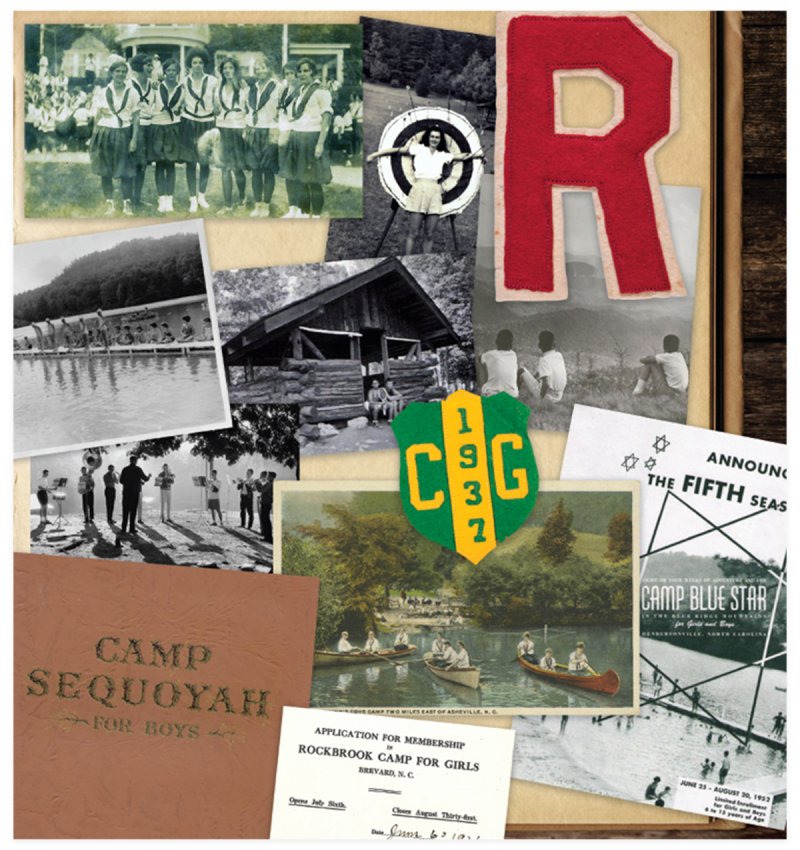Happy Campers
Happy Campers: For generations of children—spanning more than a century of campfire songs, canoe races, s’mores, and more—WNC’s summer camps have defined the season
It is a place of firsts, of breakthroughs and discoveries: A newly perfected dive in the lake. An unfamiliar archery technique that, earnestly practiced, finally finds the bull’s eye. A budding artistic talent taking shape in watercolors. A newfound confidence in exploring the natural world—and furthermore, the mysterious realm of life away from the parents. This is summer camp, the font of groundbreaking experiences, fresh friendships, and lifelong memories.
For thousands of children (and former children), summer camp is synonymous with Western North Carolina, which long ago established itself as a mecca for superlative sleepaways. The area’s natural wonders, expansive spaces, plentiful rivers and lakes, and pleasantly cool climate made for a perfect mix when the summer camp industry took flight early in the twentieth century. Throughout the mountains, summer visitors had already flocked to resorts and religious assemblies geared to adults, and “organized camps for the children were natural offshoots of these summer colonies,” notes historian Melanie English in her 2016 book, Summer Camps Around Asheville and Hendersonville.
Today, several of WNC’s original summer camps have celebrated centennials and beyond. The longevity and proliferation of the camps are testaments to their value not just as cherished chapters of childhood but as pillars of the regional economy. In 2011, the North Carolina Youth Camp Association commissioned an economic-impact study of the then-40 summer camps in four WNC counties: Buncombe, Henderson, Jackson, and Transylvania. The study estimated the camps were bringing in some $365 million to the local economy each year, generating $33 million in tax revenue and creating the equivalent of 10,000 full-time jobs.
Of course, there’s no putting a price on the quintessential summer camp experience. To celebrate and remember more than a century of summer camping in WNC, we asked some of the region’s most storied camps to open their archives and scrapbooks, to share pictures and ephemera documenting big and small moments in their history. The images are replete with reminders of why summer camp calls to the child in all of us. They offer a time capsule from a place we’ve never really left—one where kids can experience, for the first time and again and again, the marvel of summer camp in the mountains.
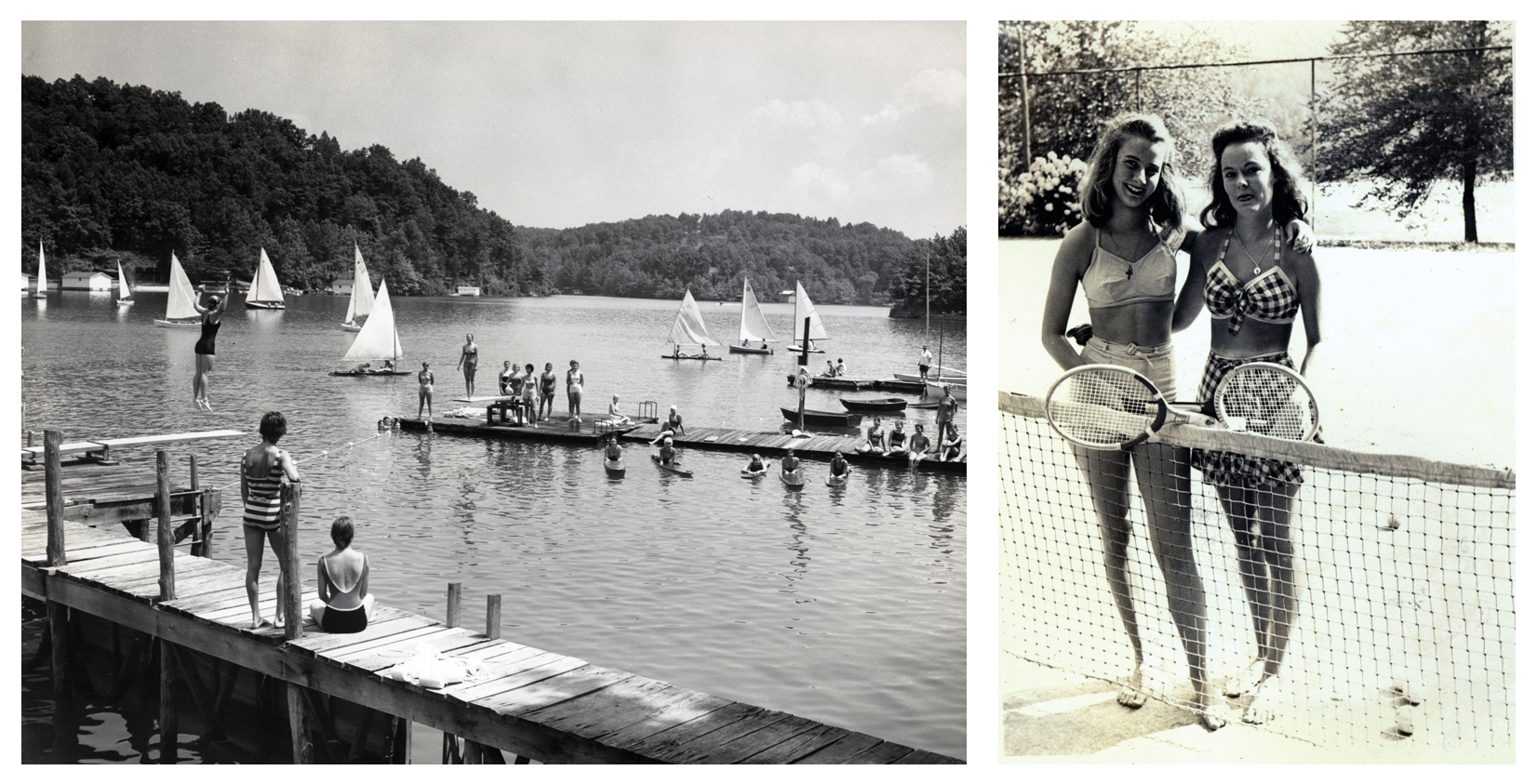
Camp Greystone
For more than 100 years, the tiny Henderson County town of Tuxedo has played a huge role as the home of Camp Greystone. The camp is fittingly located on the headwaters of Lake Summit—its founder, Dr. Joseph Sevier, was a Presbyterian minister devoted to providing girls a summer escape to both learn to swim and get closer to God. Today, his great-grandson and other descendants continue to run the family-owned camp, and generations of former campers look back on their Greystone summers with relish and reverence.
While much has changed at Greystone over the decades, the fundamentals remain the same: rigorous days of watersports, arts and crafts, horseback riding, and practicing for various performances, and nights alive with campfires, songs, prayer, and praise. Also unflagging is Greystone’s honor code, which seeks to instill the camp’s mission of helping to create confident, compassionate young women: “I commit to showing kindness, seeing the good, and taking ownership of what I do. This is how I will have fun, make friends, and glorify God in both this place and in the world.”
DISCOVER MORE:
Learn about Camp Greystone’s current offerings and rich history at campgreystone.com.
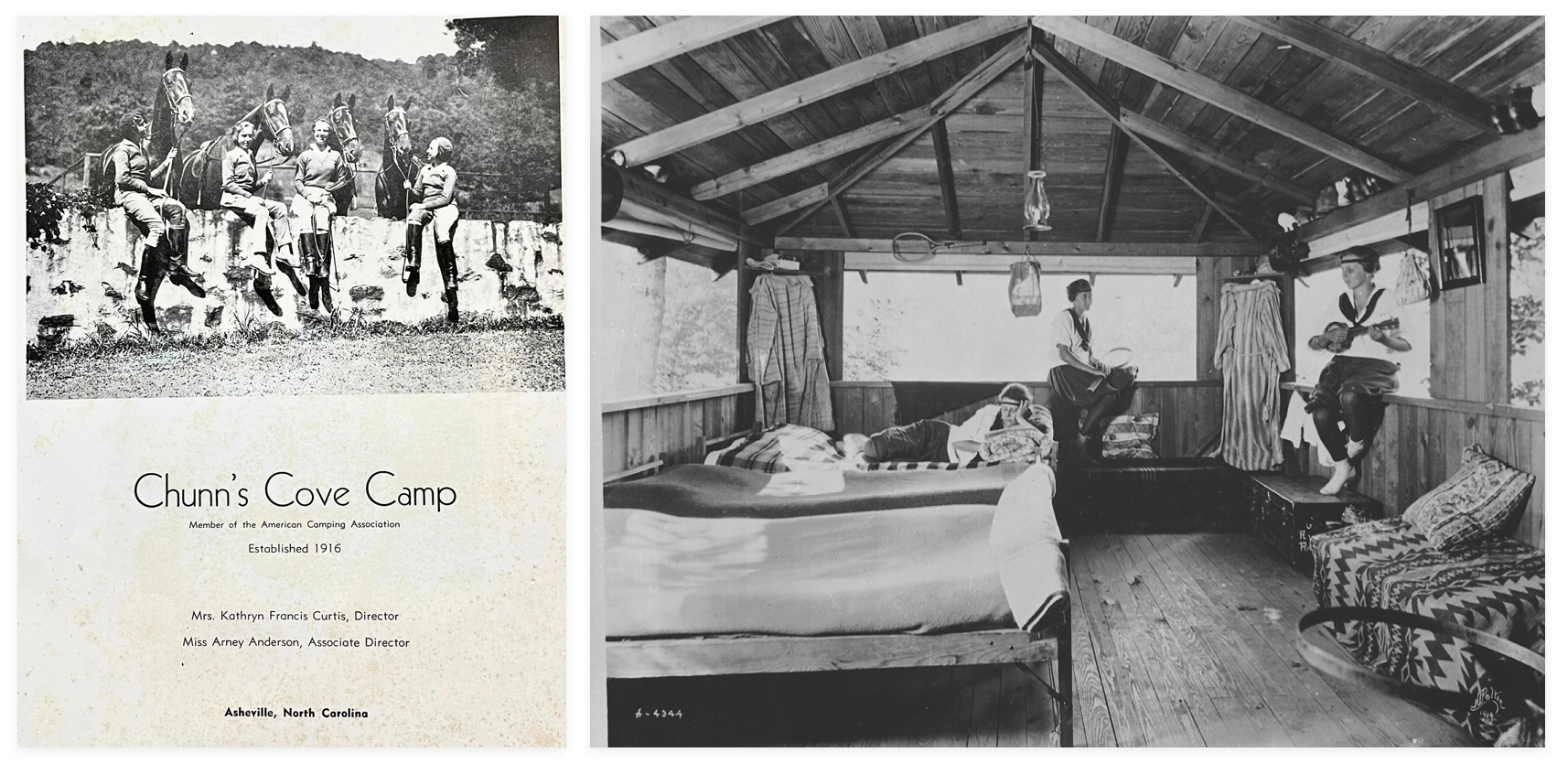
(Left) Chunn’s Cove’s 1938 brochure, shown below, announced one of the camp’s final operating seasons. For eight weeks of room, board, and activities, the camp charged $300. The brochure noted that, “a 10% discount in tuition is given to sisters” who attended camp together; (Right) Precious memories of life at Chunns Cove Camp included quality time with friends in the “kiosks” used for lodging, tranquil floats on spring-fed Lake Little, dramatic performances, and overnight camping jaunts in the nearby mountains.
Chunn’s Cove Camp
Chunn’s Cove Camp for Girls (aka Camp Allis) closed long ago, but it retains a proud legacy as one of the first summer camps to grace the mountain region. Founded in 1916 by a Buncombe County couple, Edward and Mary Allis, the camp occupied a 65-acre hideaway just three miles from Asheville.
There, campers enjoyed a, “particularly homelike atmosphere,” one brochure noted. The girls stayed in rustic kiosks that slept four. They enjoyed plenty of standard camp fare, like swimming and canoeing in the lake, horseback riding, and overnight camping trips. They also took part in more “proper” rituals like lawn bowling and tea parties at Mary’s house. “We were little ladies,” one former camper remembered.
“This high-class camp for girls has a clientele [from] throughout the South, the Mississippi River Valley, and the Ohio River Valley, as well as in the East and North,” the Asheville Citizen noted in 1928, testifying to the camp’s drawing power. “We feel that there is no greater opportunity for instilling high ideals of character and behavior than that presented by camp life,” Edward said. After helping pave the way for WNC’s booming summer camp scene, Chunn’s Cove Camp closed in the late 1930s.
DISCOVER MORE:
Melanie English’s book Summer Camps Around Asheville and Hendersonville includes historic images of Chunn’s Cove Camp and scores of other area summer camps.
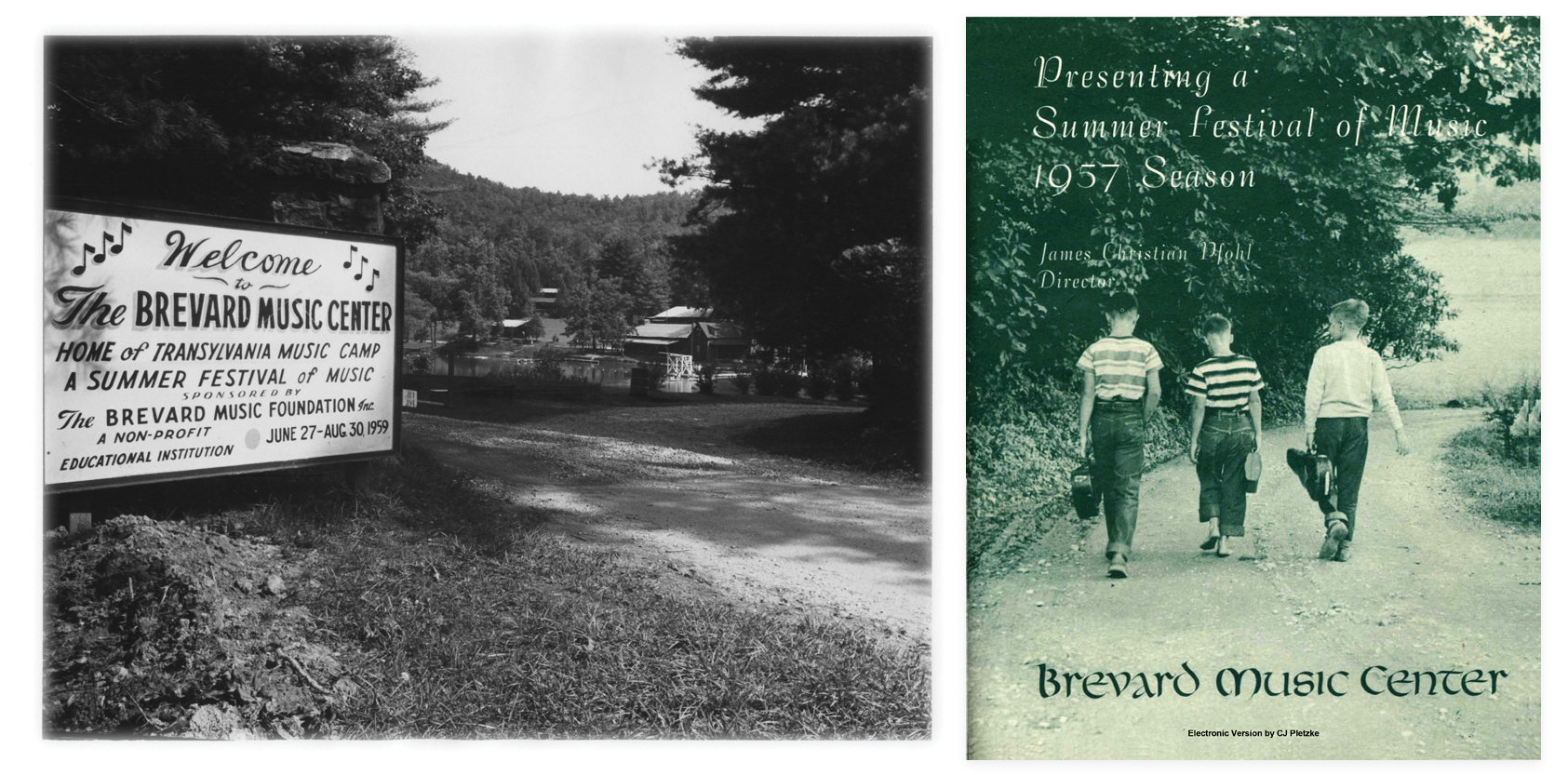
(Left) With the arrival of the camp in 1944, Brevard suddenly echoed with the sounds of classical music, and locals began a decades-long love affair with TMC’s summer recitals; (Right) In addition to their steady regimen of orchestral, choral, and dramatic training, campers plunged into all the traditional summer activities, from hikes and trail rides to watersports and plenty of plain old horsing around.
Transylvania Music Camp
While many WNC camps could justly claim to be “something to see,” one in particular was decidedly something to hear. Transylvania Music Camp was the brainchild of James Christian Pfoul, a Winston-Salem native and devoted musical educator. He founded the music department at Davidson College, where he also started a summer music camp for boys in 1936. In 1944, Pfoul relocated the operation to a former camp site in Brevard, made it coeducational, and christened it Transylvania Music Camp.
The program quickly flourished in its new home, so much so that in 1946 the camp staged the first Brevard Music Festival at the end of the session. In 1955, Transylvania Music Camp was renamed Brevard Music Center, an institution that has evolved over the decades to become a nationally recognized musical haven of both education and expert performances. Pfoul, who passed away in 1983, would be pleased to know that his dream of a world-class summer program lives on today, with some 700 young musicians studying there each session.
DISCOVER MORE:
Visit brevardmusic.org to learn more about TMC/BMC history and check out Brevard Music Center’s current summer educational and concert offerings.
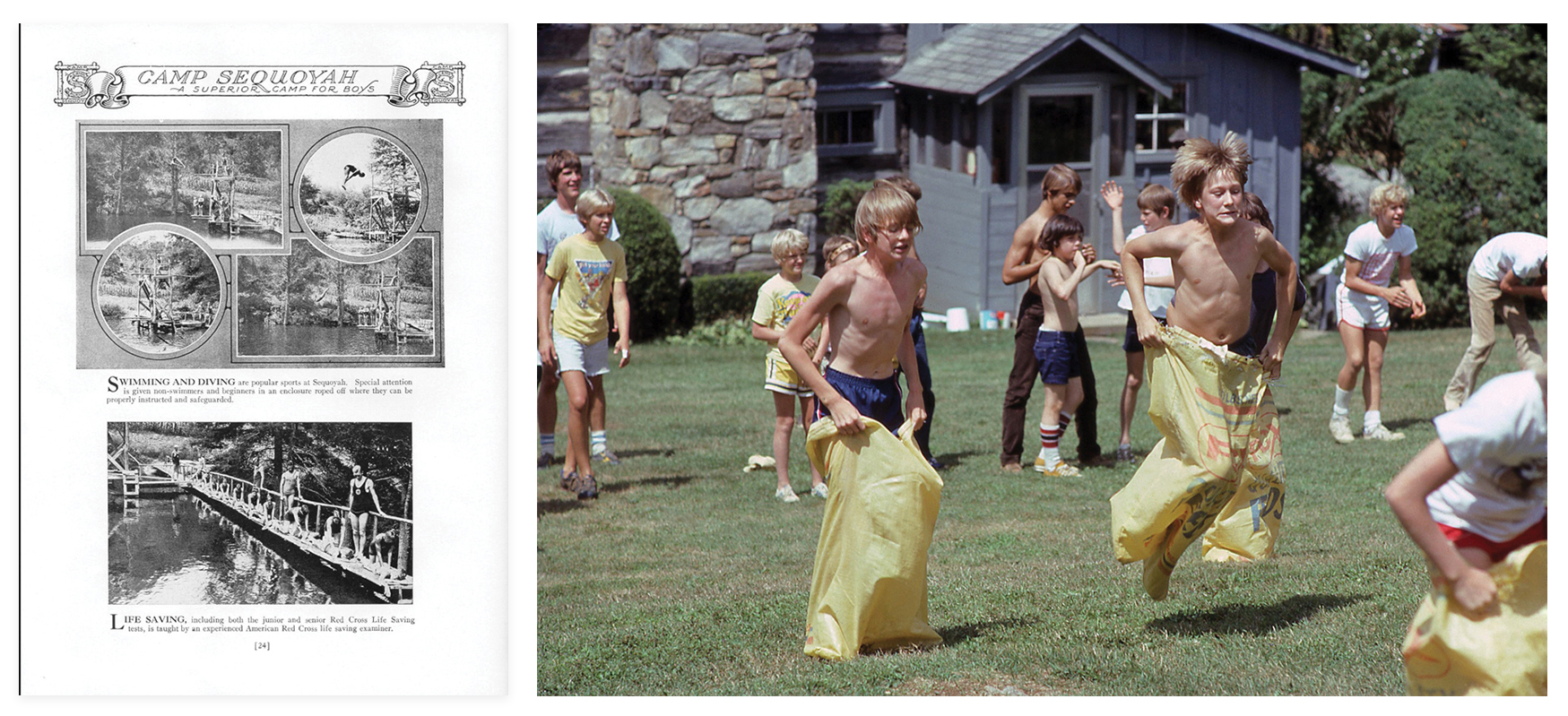
One camper shared his notes on Sequoyah in the 1940s: “The memories of those three summers are wonderful. They still stand out clear as a bell. Hikes to Lovelace Gap and Bald Knob, to Hawk’s Bill and Craggy Gardens, and the one long hike to Mt. Mitchell. … Cabin suppers, watermelons in the middle of the night, cleaning kerosene lanterns, catching snakes, slipping off to the store at Beech … [and] nighttime Indian dancing in full regalia.”
Camp Sequoyah
C.Walton Johnson touted “a camp with a purpose,” and Camp Sequoyah was assuredly that. A veteran of several YMCA camps, Johnson founded his own boys camp in 1924, in Buncombe County’s Reems Creek Valley. Camp Sequoyah proved a pioneer not just for WNC but for the entire Southeast, and it remained a leading regional institution until it closed in 1978.
Johnson, affectionately known as “Chief,” stressed character-building through not only the traditional camp activities but also rigorous study of nature and outdoor skills training. Wood crafting, fishing, and rock climbing were popular, as was backcountry horseback riding. Johnson also stressed Native American customs and spiritual traditions. A practice not uncommon at American summer camps at the time, such rituals appropriated native culture in ways that can seem cringe-worthy today. But in a stab at authenticity, Johnson hired practitioners from the Eastern Band of Cherokee Indians to impart genuine stories, dances, and other folkways.
With its standout offerings and stellar reputation, Camp Sequoyah built a national constituency. By 1962, it was drawing campers from 32 states. Sequoyah added a sister camp for girls in the ’20s that ran for two weeks per year, and even hosted a regional counselor training institute to share the camp’s best practices. And while the camp held its final session in the summer of 1978, since then, former staffers and campers have banded together to preserve Camp Sequoyah’s legacy by sharing camp archives, preserving key parts of the former camp site, and holding regular reunions.
DISCOVER MORE:
Camp Sequoyah’s remarkably active alumni group maintains a website, campsequoyah.net, devoted to both the camp’s history and the group’s ongoing preservation efforts at the former camp site.
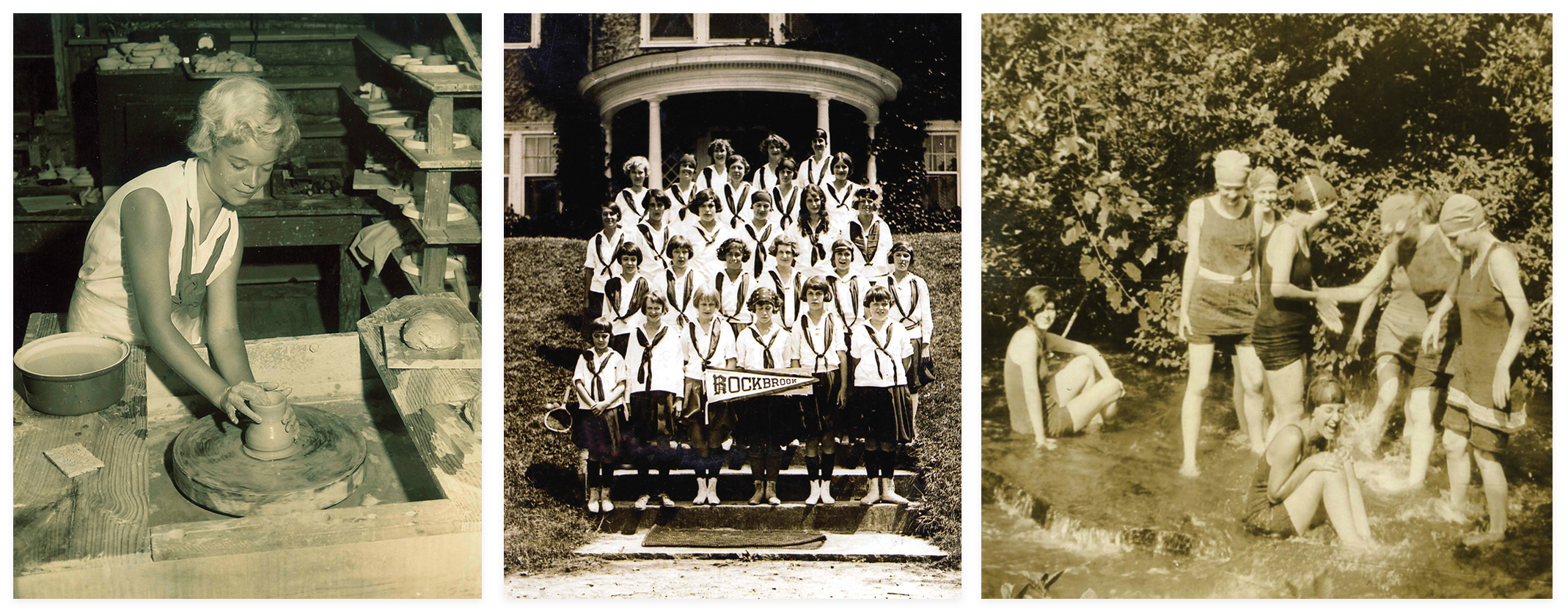
Rockbrook Camp
Perhaps it’s no surprise that some of the greatest summers on Earth—or at least in WNC—were set in motion by a great-granddaughter of the legendary showman P.T. Barnum. A Connecticut native raised in South Carolina, Nancy Barnum Clarke founded Rockbrook Camp for Girls, near Brevard, in 1921, joining the early wave of popular Transylvania County camps that remain in operation today.
Rockbrook was big on the usual camp activities like lake sports, horseback riding, singalongs, and “camping parties”—overnight excursions in the mountains. Reflecting its founder’s refined background, the camp also featured expert tennis instruction, lawn dancing classes, water ballet, and traditional (but advanced) arts and crafts. “Mountain crafts are especially noteworthy here,” noted a 1937 article about Camp Rockbrook. “Weaving, basketry, pottery making on the age-old potter's wheel, and other handwork (like sewing, knitting, and patchwork) practiced by the mountain folk of a bygone age exercise a charm that intrigues the girls of the 20th century.” Some of those specialties still shine at Rockbrook, well into the next century.
DISCOVER MORE:
As Camp Rockbrook prepares for its 103rd summer, visit rockbookcamp.com to review its current offerings as well as an informative blog dedicated to the camp’s illustrious history.
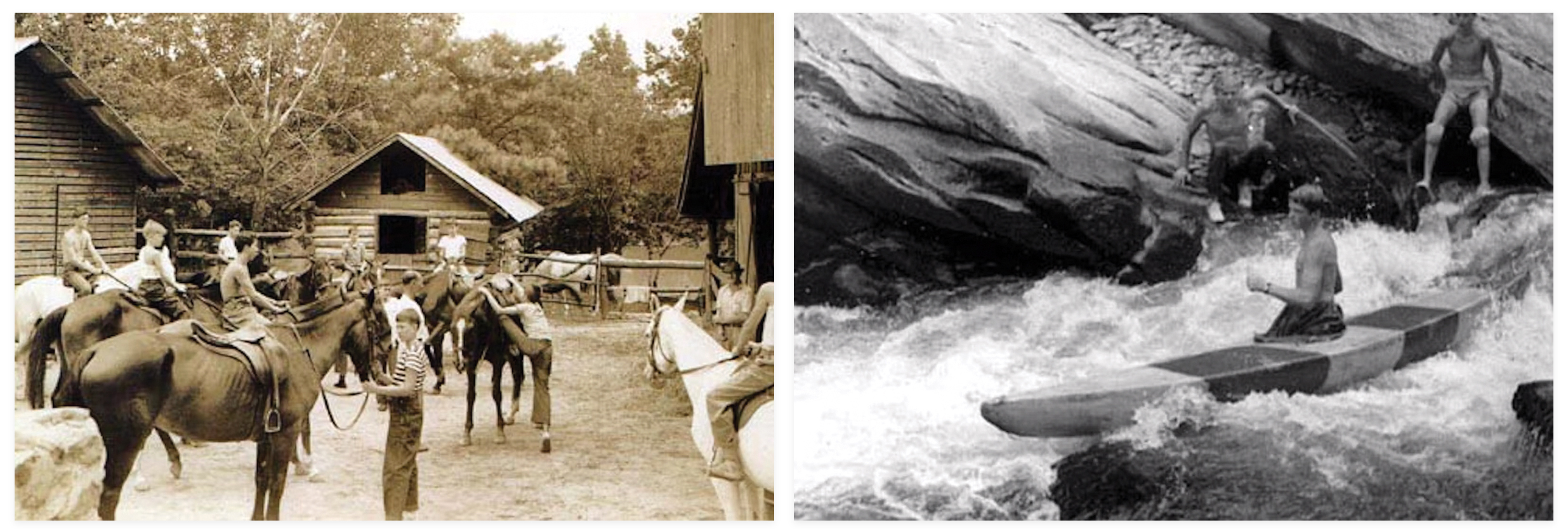
Camp Mondamin
Frank Bell Sr. of Henderson County was a man perpetually moved by water, as any student of Southern whitewater rafting can tell you. He was famous for tackling WNC rapids long before today’s cutting-edge kayaks hit the rivers. And when Lake Summit was formed in 1920, Bell saw an aquatic opportunity: two years later, he founded Camp Mondamin on its shores, establishing what was to become one of the most venerable boys camps in the region.
Mondamin is still at it today and still owned by the Bell family, welcoming hundreds of campers to enjoy watersports at Lake Summit and much more each summer. Back in 1922, Frank Bell, aka “Chief,” started with barely 30 boys and little more than tents to shelter them. But his camp quickly grew in size and stature, becoming a center of outdoor adventures both at Mondamin and at nearby rivers and mountains. “Physical sturdiness, mental resourcefulness, a happy social adjustment, spiritual growth—cleanliness, generosity, and courage in all things—these are the goals of Mondamin,” explained a 1927 camp brochure. The same has held true for Camp Green Cove, a girls camp also on Lake Summit that was opened by the Bells in 1945.
DISCOVER MORE:
Visit mondamin.com to learn about Camp Mondamin’s current programs and see historic photos and early brochures from the camp.
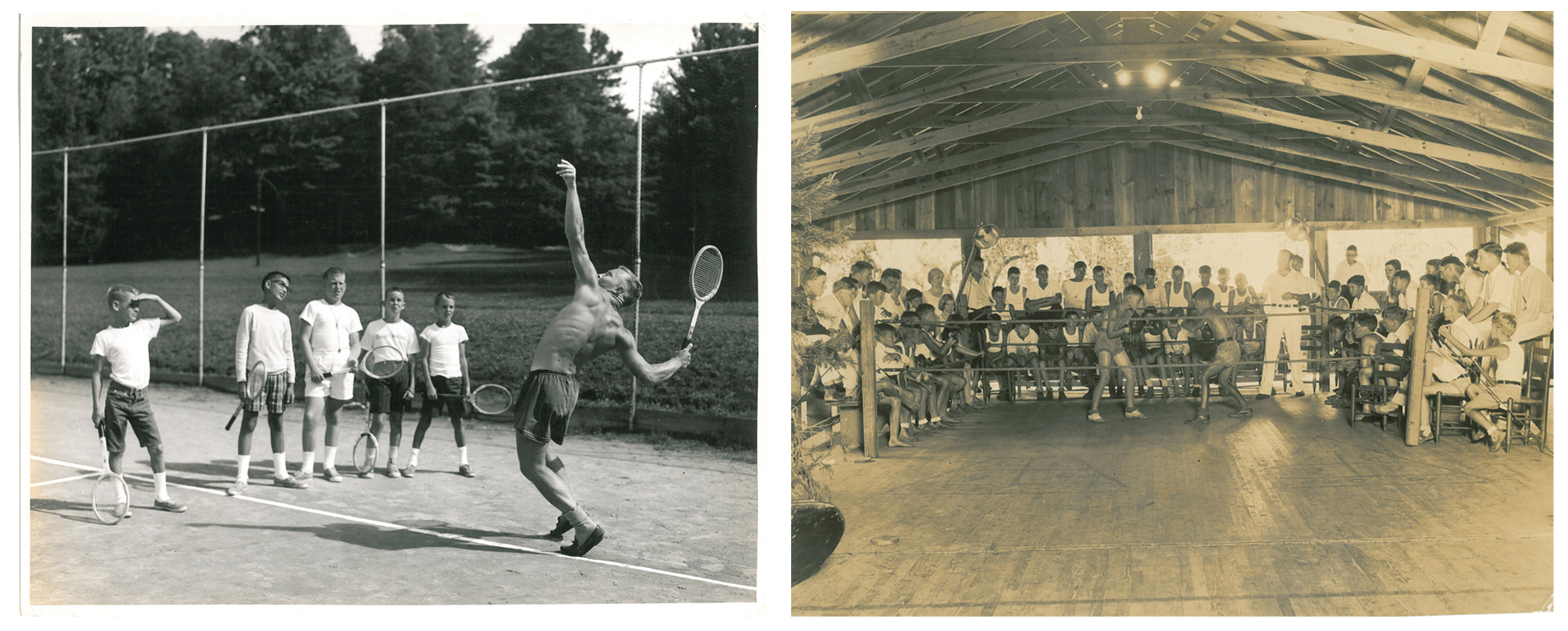
Camp Carolina
Camp Carolina has much to celebrate in this, its 100th year. The Brevard institution, “where boys become men,” was founded by the industrious Professor D. Meade Bernard of Florida, who had previously helped run nearby Camp Sapphire. His prior experience led him to plan his new camp carefully, and Camp Carolina quickly garnered accolades. In 1926, Redbook magazine deemed the camp “physically the peer of the best camps in America and Europe” and heaped on the praise: “There is here also, besides wood, stone and water, fine sports fields, abundance of good boy food and a hardy comfort, a great opportunity for that culture which will produce character and impart distinction and rugged humanity to the adult life of Carolina’s alumni.”
Early on, Camp Carolina was noted for its particularly cerebral staff, as Bernard recruited counselors from top colleges. But lest anyone get the wrong idea, he stressed that summer camp’s chief purpose was hardly academic. “It is only fair,” he noted, “to let parents know that the atmosphere of a summer camp is one of wholesome fun rather than serious study. … Parents are advised to require no academic work of the boys unless it is necessary.”
DISCOVER MORE:
Camp Carolina will celebrate its centennial with special events this August. Visit campcarolina.com for details.
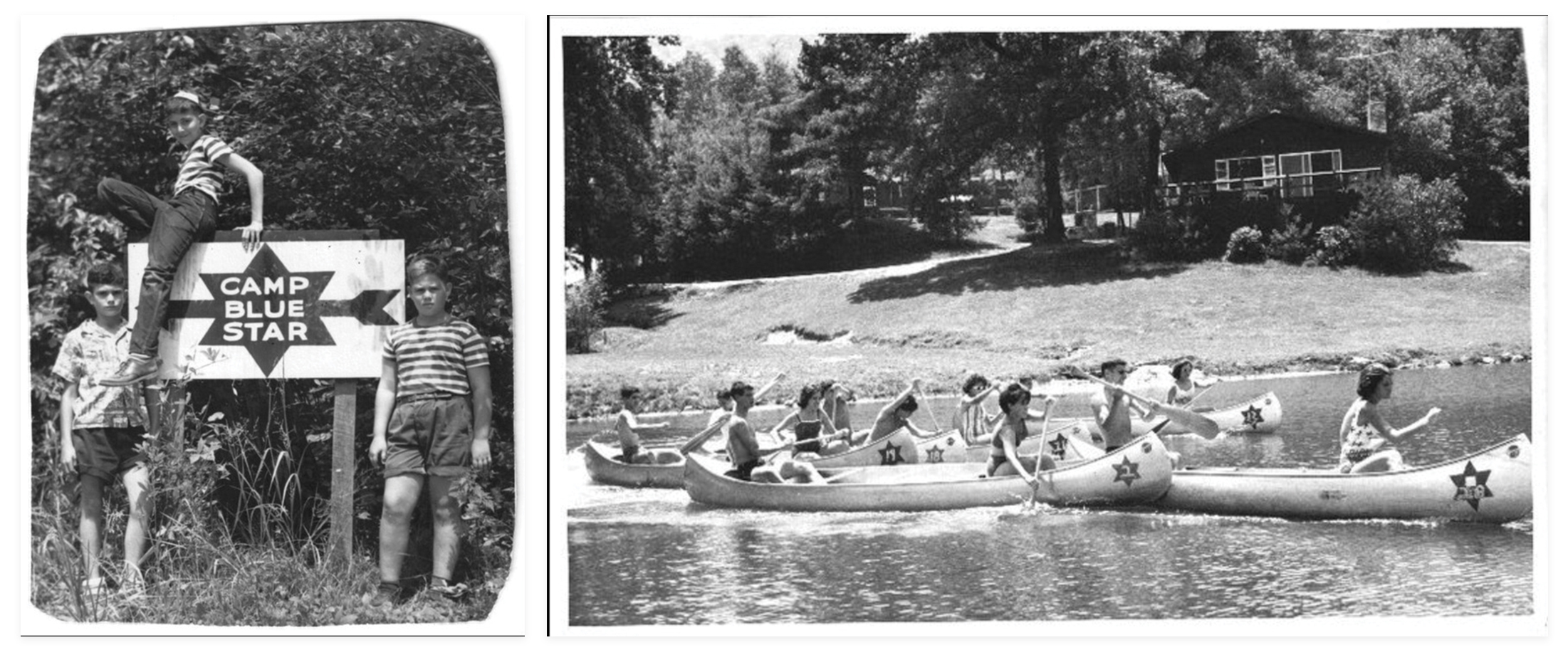
Camp Blue Star operates six individual “Blue Star Camps”—separate summer camp sessions geared to age and gender groupings. In almost eight decades of operation, Blue Star has hosted close to 100,000 campers, staff members, and other visitors.
Camp Blue Star
Camp Blue Star, one of the first Jewish summer camps in the Southeast, was founded in 1948 in north Georgia and relocated to southern Henderson County, at the base of Mount Pinnacle, in 1950. It was started by the Popkin brothers, who had served in World War II and were determined to establish a haven for young Jewish Americans to gather and share their heritage and culture.
“Camp Blue Star was the best 10 years of my life,” one former camper remembers. “Growing up in the South was tough for a Jewish child, especially the only one in my elementary school. When I arrived at Blue Star, I was like everybody else—accepted for who I was, not outcast by ignorance.”
Today, the third generation of the Popkin family runs Camp Blue Star. The late Herman Popkin, the camp’s longtime director, beautifully summarized summer camp as, “a time in our lives when youth was sweet and good; when campfires and friendships were kindled together; when the stars were brighter than any store-bought diamonds; when mountain streams ran clear and many hearts beat as one; when rain fell like kisses on uplifted faces; when a walk in the woods was as refreshing as a dive in our spring-fed mountain lakes; when a song around a campfire echoed not just in the nearby hills but even had a chance, one believed, to be heard worldwide.”
DISCOVER MORE:
Learn more about Camp Blue Star’s history and current operations at bluestarcamps.com.
